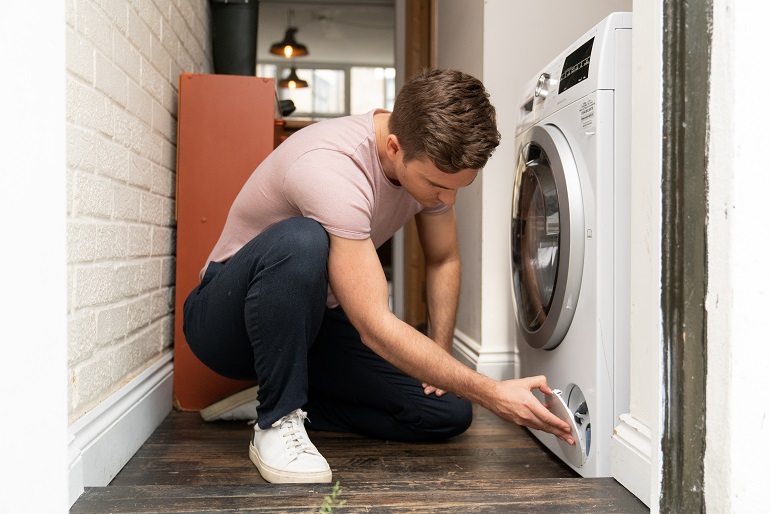In domestic life, there are few things more disappointing than finding that your just-washed clothes are still sopping wet. You can put them on a spin cycle or wring them out, but that doesn’t solve the underlying problem. So what can you do about a washing machine not draining?
Thankfully, there are some simple fixes for a washing machine that doesn’t drain. If you feel able, we recommend trying these tips before you think about booking a washing machine repair.
Why your washing machine might not be draining
It’s always best to check the appliance’s manual for any guidance first. There may be a troubleshooting section with advice on drainage problems. Some washing machines will also show an error code that indicates where the problem is.
As a rough guide, we’ve collected the most common reasons for a washing machine not draining here.
Clogged filter
The most common reason for a washing machine not draining is a clogged filter. The filter is there to stop solid things like coins or buttons from getting into the drain hose. Over time the filter can get clogged with fluff, hair or paper from your pockets.
Blocked drain hose
If something manages to get through the washing machine filter, it will end up in the drain hose. Alternatively, the hose could be kinked or squashed, restricting the flow of water. This may have happened if you recently moved the washing machine or something nearby.
Mechanical faults
While it’s quite easy to clear blockages yourself, you will need an expert to fix any mechanical faults. Some of the washing machine parts that could stop it from draining include:
- Water pump
- Drive belt
- Door or lid switch
How to fix a washing machine that’s not draining water
Here we’ll give you tips on how to solve common blockages in most washing machines. The details of each washing machine are different, so always check the manual first. If you’re unsure, you can always get a professional to repair your washing machine.
First, you must turn the machine off at the mains and unplug it to protect yourself from power surges.
You’ll need these items to hand:
- The manual for your washing machine
- Washing up gloves
- A bucket
- Some towels
- A soft-bristled brush (like an old toothbrush)
- A screwdriver
Once you’ve unplugged the washing machine and got these items, you’re ready to start.
Check the pump filter for blockages
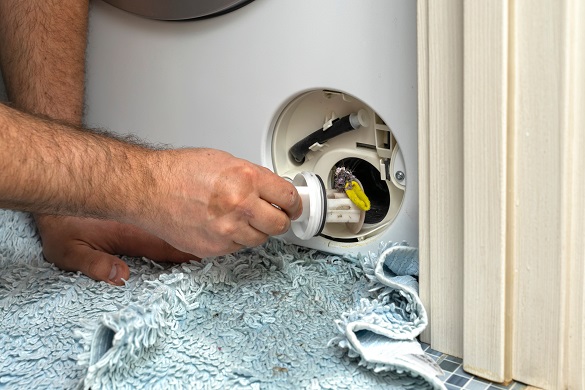
The filter on most washing machines is located under the door, on the front. For top-loading washing machines it's usually on the back of the machine.
The filter unit may be concealed under a panel. If you can’t take the panel off by hand, it should come off with a screwdriver.
Now you’ll want to put towels down around the filter area. If you can fit a plastic container or pan under the filter, that will also help catch any water.
Most filters are cylindrical, so you’ll see a circle that you typically have to unscrew by hand. Pull it out and see if anything solid drops out, like a coin or hair clip. Wearing protective gloves, you can also reach into the filter and remove anything that’s stuck in there.
Now all you need to do is replace the filter and plug the machine back in (being careful to dry your hands first). Then give it a test spin to see if it drains better.
Unblock the drain hose
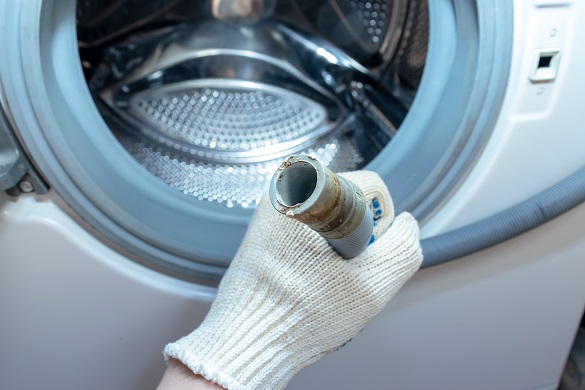
To unblock the drain hose, you’ll need to pull the washing machine away from the wall. Be careful not to pull it so far that it stretches the hose behind, though.
Now you should be able to see the pipes leading to the machine. The cold water feed typically has a blue handle, which you’ll want to turn closed.
Get your towels and a container or bucket you can fit under the piping. Unscrew the drain hose from the washing machine, then pour any water out of it into your bucket. Have a look down the hose to see if there’s any visible blockage.
The drain hose runs from the washing machine to a U-bend pipe, usually found under the sink. Now you can look down the U-bend pipe to see if it’s clear. Then unscrew the bottom of the U-bend, putting a container underneath to catch the water. There should just be water in the U-bend — if not, that means a blockage you have to remove.
Other faults that might cause issues with your washing machine
Beside the two common reasons we’ve mentioned, there are a few other faults that often stop a washing machine draining.
For any mechanical faults, we recommend using an approved engineer to fix them. Otherwise, you may risk damaging the appliance and making it unsafe to use.
Pump drive belt
Your washing machine’s drain pump may run on a belt that connects to the motor. If this belt breaks or gets loose, the drain pump won’t work as it should. This is a job for a professional engineer to fix.
Door or lid switch
Most washing machines have a switch inside the door or lid that senses when you shut it. If this switch gets stuck or damaged, the appliance may not know when to drain. Try opening the door or lid and checking if the switch seems stuck or broken. If so, you’ll need an engineer to replace it.
House drain clog
If you can, check that the outside drain isn’t pooling water. A build-up of water in your sink may also indicate an issue in the pipes. For either of these issues you can try some sink or drain unblocker.
How to prevent problems with your washing machine
There are a few simple things you can do regularly to keep your washing machine happy.
- Empty the pockets of your clothes before putting them in the machine.
- Use no more than the recommended amount of detergent.
- Check and clean the washing machine filter at least once a week.
- Run a hot, empty cycle on your washing machine once a month to clean it.
Our blog is loaded with more related articles
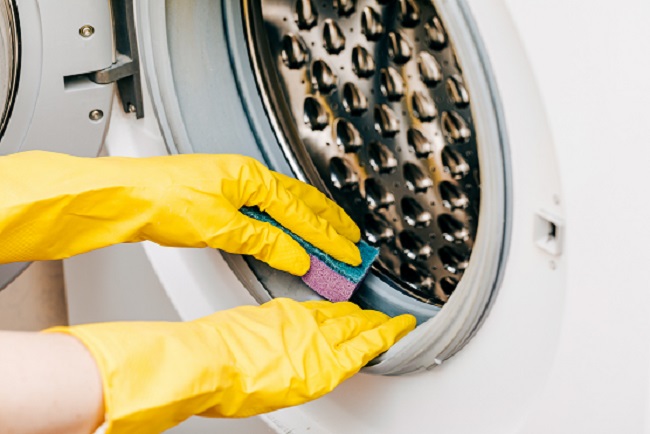
Washing machine tips
How to clean your washing machine
Regular cleaning of your washing machine is important to keep it running smoothly. Find out how to clean your washing machine,...
Read more

Washing machine tips
How to extend the lifespan of your washing machine
The humble washing machine is the workhorse of a household. By following some simple hints and tricks you could add a few more...
Read more
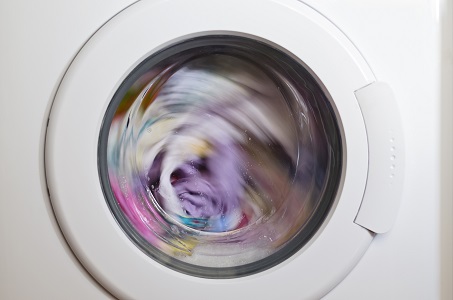
Washing machine tips
How to keep your washing machine spinning
It's important not to take your hard-working appliance for granted by making sure you give it some TLC. This can be done th...
Read more
